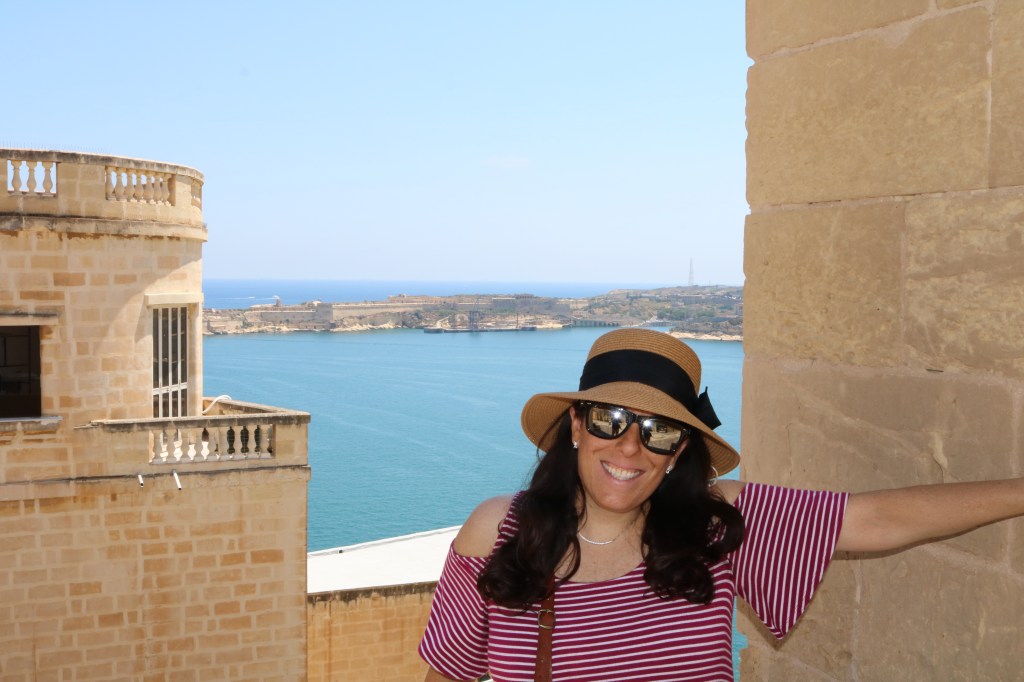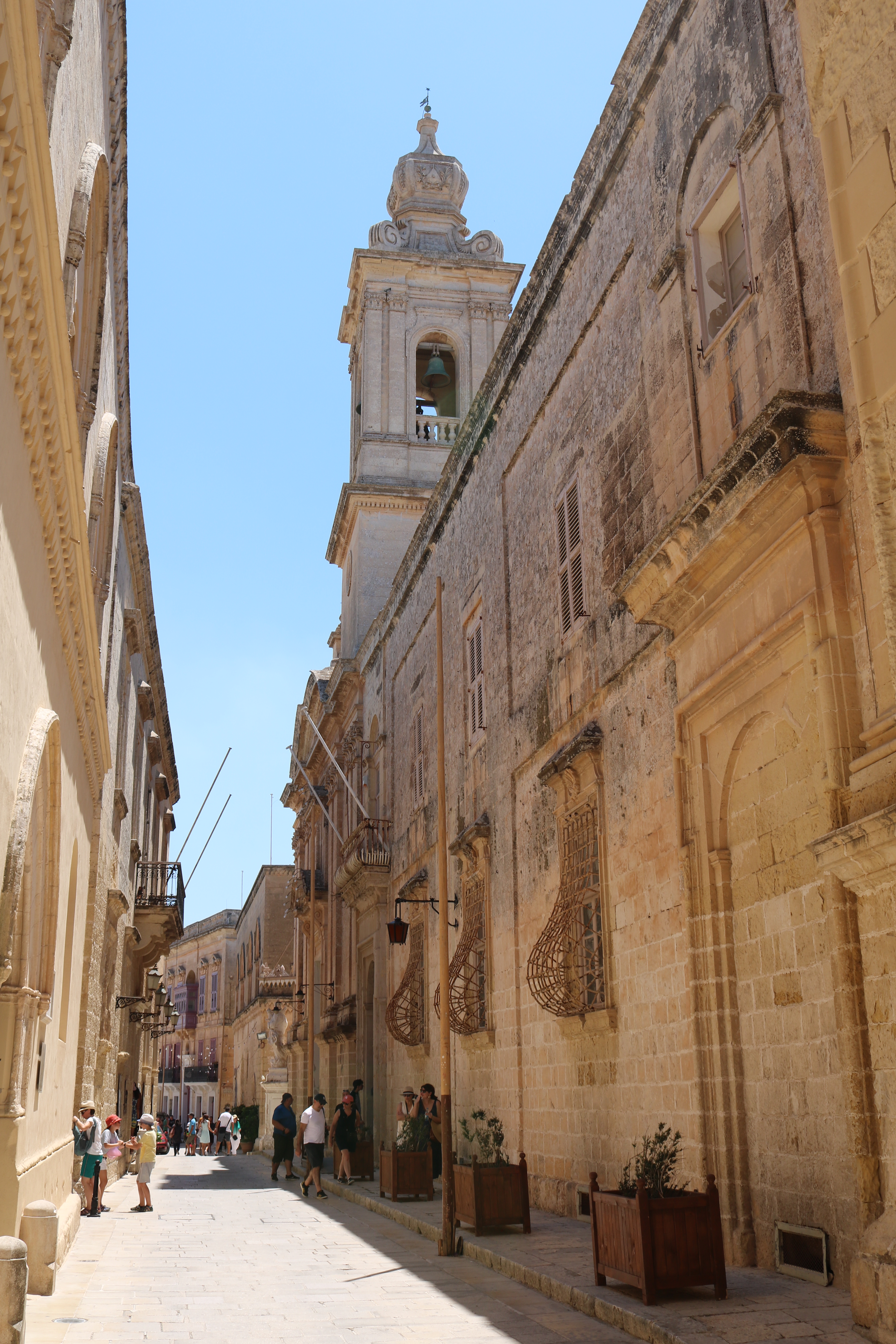
So here’s a funny story… I tend to put potential travel destinations in my phone’s weather app, so I can see what the weather is like, if I’m missing out, should I visit in fall, etc. When my husband saw a picture of Malta online, he said “We should go there sometime”. So I promptly typed “Malta” into my phone. It was late winter and I was curious if this was a destination I should wait until spring or summer to visit. Interestingly enough, Malta had the worst weather in the Mediterranean! I mean, EVERY time I checked my weather app, it was cold and usually snowing. WTH?! The snow continued, through spring. This just wasn’t right, and I told my husband we were never going to Malta. Fast forward a few months, and I figured out my mistake… Malta is the name of the island, not a specific city on the island. There is, however, a Malta in the United States, in a very cold (in the winter) state called ILLINOIS. Once I typed in Valletta, the weather improved! I’m here to tell you the COUNTRY of Malta is very hot and sunny, and probably doesn’t snow at all, ever. So crisis averted, and we booked a trip to Malta and had a great laugh at my expense.

Malta is a stunning island, with so much to offer. It is packed with breathtaking views, gorgeous architecture, natural sites, and a wealth of history full of change and conquest. Archaeologists have determined that the Maltese Islands were settled as early as 5200BC! Malta lies on a popular trade route, and has been colonized by many as a result. Malta has been ruled by the Greeks, Romans, Phoenicians, Arabs, Normans, French, and British, among others. In 1814, Malta became part of the British Empire, and it’s location played a role in both World War I and World War II. Malta remained a part of the British Empire until it gained it’s independence in 1964. However, many “signs” of it’s British past are evident on the island; in Malta you drive on the left side of the road, and there are still many red telephone booths and British chain stores on the island. Though it has British roots, the close proximity to Sicily influences the restaurant industry in Malta. It’s diverse past and unique history shapes the island and it’s inhabitants. Currently, Malta is part of the European Union and is largely Catholic, with a large amount of stunning Cathedrals and Churches. I was shocked to see how much religion influences life on the island. In the summer months, it is common to have a “feast” or celebration, for a saint, as often as every weekend. While the national language is Maltese, many people speak English and Italian as well, and communication was not a problem.

The biggest mistake I made when booking our trip to Malta was not doing enough research BEFORE booking flights. I have a habit of finding good flight deals (helllllloooo Ryanair), buying them, and then researching the destination afterwards. Had I done my research first, I would’ve learned how MUCH there is to do on Malta and would have planned a longer stay. I assumed since it was a small island, there wouldn’t be much to do there, but that couldn’t be further from the truth. We spent four full days there, and it was not nearly enough time to see everything. The entire island is populated with cities, history, natural sites, ancient temples, cathedrals, etc. We barely scratched the surface on Malta and our four days was jam packed! We did spend two days exploring the nearby islands of Gozo and Comino; more on that in a future blog.

We booked our flights on Ryanair, and flew from London Stansted to Luqa, Malta. I had been watching flights for quite some time and gather that flying to Malta is a little more expensive than flying into mainland Europe, but we were still able to get a decent deal on flights. (We arrived around 9pm and it was an easy taxi from Luqa to Sliema. The airport has a taxi stand where you prepay, making it easy to pay by credit card.) With flights out of the way, it was time to find a hotel. Since we were going in mid-July and it is such a hot and humid island, I limited my search to hotels with AC. There are so many options on where to stay in Malta depending on what you want to see and get out of your trip. You can stay in historic old cities, or beach areas. We choose to stay in Sliema, which is essentially an area populated with hotels and restaurants, that has easy access to Valletta (the capital) by ferry. We stayed at Labranda Rocco Nettuna Suites, and found it to be spacious and cool, while being convenient to our needs. We were in walking distance to restaurants, ferries, and public transportation. Part of the reason we chose this hotel was the rooftop pool, but ironically we never used it because we were so busy exploring. We were happy with this hotel, and would definitely stay here again. However, if you are looking for a beach hotel, this isn’t it. There is a public beach about a 15 minute walk away, but it is rocky. The Maltese make the best of what they have – which is a lot of limestone! They lay out on hard rock surfaces, instead of soft sand beaches. The Maltese definitely make the most of their island and appear to enjoy life to the fullest.

Upon arrival, we checked in to our hotel, and immediately went out to explore even though it was late at night. We headed down to the main strip on Sliema, in search of some dinner. We quickly realized that Malta has a good nightlife scene as many people were out enjoying dinner or drinks. We had a meal at Portopalo that was delicious (especially my risotto) and we chatted over a carafe of Maltese red wine. (we even returned another night for wine and an appetizer). The next morning we hit the ground running! We walked to the Sliema Ferry to head to Valletta. The ferry system is fairly inexpensive and a time saving way to travel from Valletta to Sliema or vice versa. Valletta is a walled city, and the beautiful capital of the island. As you climb the hills of the city, you are rewarded with views down the street, and of the water. There are many shops and quaint alleys to explore in Valletta. We spent time exploring St. John’s Co-Cathedral, a beautiful Baroque cathedral. You have to pay to enter, but you receive an audio guide. They are very strict about having shoulders and knees covered, but will give you something to wrap around your shoulders or legs if needed. The Cathedral is stunning and lavishly decorated with gold, and we spent about an hour touring it. After St. John’s we walked past the Grandmaster’s Palace and headed to Upper Barrakka Gardens. From the gardens, we took an elevator down to the street below (Valletta is very hilly) and then took a ferry to visit “The Three Cities”.


In Malta, you will hear the phrase “The Three Cities” to describe an area. It refers to the collection of three fortified cities: Birgu, Senglea, and Cospicua. It is easy to travel to “The Three Cities” by ferry from Valletta. I enjoyed this part of Malta because it was less crowded than Valletta and Sliema. While there aren’t quite as many shops and restaurants, and it appears to be more residential, it was still fun to walk around, and provided gorgeous waterfront views! I enjoyed marveling at (and envying) the grand sailboats and yachts docked in the harbor. After admiring the beautiful scenery in Birgu, we paused for a delicious lunch at D’Centre Vittoriosa, which has an adorable patio set up in the alley. I had a traditional Maltese salad which was filled with local cheeses, capers, sausage, and vegetables. It was phenomenal! After lunch, we wandered a bit more, enjoying the boats in the harbor and snapping more pics, before boarding the ferry back to Valletta (and then another ferry back to Sliema). It sounds overwhelming with the ferries, but in reality it is quick and easy.


During our four days in Malta, we spent time on two of the “other” Maltese Islands, Gozo and Comino. We booked day trips for each one, and those will be their own blog post as I don’t want this one to be too lengthy. In addition to touring Sliema, Valletta, and “The Three Cities”, we also spent time in the city of Mdina and Rabat on mainland Malta. Mdina is a fortified city that is nicknamed “the Silent City”; it’s history dates back to the 8th century BC. Mdina is a popular place for tourists, and while it’s narrow streets are often crowded, cars are forbidden inside the gated walls. Our first stop in Mdina was St. Paul’s Cathedral. The Cathedral was beautiful and we also stopped at the museum as well. Afterwards, we wandered the shops and strolled the quaint streets. We also headed to Rabat, and enjoyed some lunch and more window shopping.





During our stay in Malta, we dined on regional food and treated ourselves to several glasses of Maltese wine. One thing I love to do is try local beer and wine. Having enjoyed the red wine so much on our first night, we never did make it to sampling the beer — we ordered Maltese wine each night and loved it. Everything we tried was great for the price point. One night, we ate at a Sicilian restaurant in Sliema (and had more Maltese wine!) called Anciova Sicilian. We had a great meal and good service. One of our favorite culinary experiences to date, was a dinner we had in Valletta at a place named Legligin. The restaurant is slightly different; instead of ordering from a menu, the chef decides what to prepare, and you are served 7 courses. I really wish I had taken pictures with my camera, because the meal was amazing, but the setting was intimate and it didn’t seem appropriate at the time. We were served traditional Maltese dishes such as mussels, octopus, sea bream, and rabbit pate. It was slightly out of our comfort zone to allow the chef to decide for us, but we loved it and consider it a worthwhile and exciting experience. I hope your visit to Malta leaves your stomach full and happy!
Tips for Visiting Malta
- Do your research and decide what you want to see and how long you want to stay. There was so much more we wanted to do, if we had more time.
- Wear shoes with good traction. Many of the hilly streets (particularly in Valletta) have stone that is worn and extremely slippery. I almost fell at least 8 times.
- Remember, Malta was most recently under British rule. Your European adapters will do you no good; bring your British ones as they have the same outlets as in the UK.
- Drink the local wine; it’s a good value!
- Consider the season. We were told by guides, that many restaurants and places are closed in the winter.
- During the summer, book reservations at restaurants in advance to avoid disappointment.
